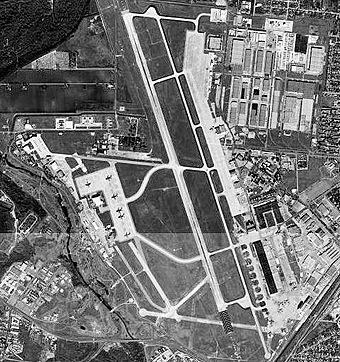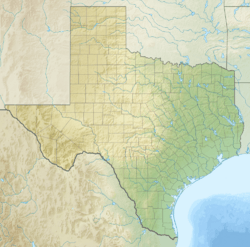Kelly Field Historic District facts for kids
Quick facts for kids |
|
|
Kelly Field Historic District
|
|

Kelly Field Historic District, middle right of the runway
|
|
| Location | San Antonio, Texas, US |
|---|---|
| NRHP reference No. | 03000626 |
| Added to NRHP | July 10, 2003 |
The Kelly Field Historic District is a special area in San Antonio, Texas. It's the central part of what used to be a big air force base. This district was added to the National Register of Historic Places in 2003. This means it's an important place in history.
The district includes 58 buildings, structures, and sites. They are located east of the runways. The area is bordered by Billy Mitchell Road, Wagner, England, and S. Frank Luke Drive. Another part with officer homes is near Chennault Street and Chennault Circle.
Contents
A Look Back: Kelly Field's Story
Kelly Field has a long and interesting history. It played a big role in training pilots and supporting the military.
Starting Up: World War I
Camp Kelly started on May 7, 1917. It was a training place for US Army pilots. Support staff also trained there during World War I. The first airplanes arrived on April 5, 1917. The very next day, the United States declared war on Germany.
More training meant they needed more space. The original field became Kelly Field No. 1. New facilities were built and called Kelly Field No. 2.
Growing Stronger: Between Wars
After World War I ended in 1918, military spending was cut. Both Kelly Field No. 1 and No. 2 stopped training pilots. Instead, they became supply depots. In 1925, they got new names. Kelly No. 1 became Duncan Field. Kelly No. 2 became Kelly Field.
This Kelly Field (the old No. 2) had an advanced flying school. A famous pilot named Charles Lindbergh trained there. He earned his pilot wings on March 14, 1925. He even graduated first in his class!
In 1926, the Army Air Corps planned to grow. So, both Duncan Field and Kelly Field became permanent training places. They built many new facilities during this time.
War and Beyond: World War II to Closure
During World War II, the two fields joined together. They were called the San Antonio Air Depot. It was the largest maintenance and supply center in the United States. This meant they fixed and stored a lot of planes and equipment.
After the war, in 1947, the National Security Act of 1947 created the United States Air Force. Kelly Field was renamed Kelly Air Force Base. It became a separate branch of the military. For a long time, Kelly Air Force Base was the biggest employer in San Antonio.
In 1995, the government started changing military bases. Kelly Air Force Base closed in 2001. Part of it joined with Lackland Air Force Base. The rest was taken over by a Texas group. They turned it into a center for businesses and military industries.
Historic Buildings and Features
The Kelly Field Historic District includes buildings and areas built between the two world wars. More construction happened after World War II. These properties are important for two main reasons:
- They are linked to important historical events.
- They show unique building styles or are part of a special design.
Some buildings are called "contributing." This means they help tell the story of the district. Others are "non-contributing." They might have been built later or changed a lot.
Contributing Buildings
These buildings and features are key parts of Kelly Field's history:
- Feature A, B, C, D (around 1940): These include the main esplanade, sidewalks, streets, and landscaping. They show how the base was planned.
- Building 1607 (1943): This was a weather building and storage area.
- Building 1609 (1942): Used for storing Norden bombsights. These were important tools for bombing during WWII.
- Building 1610 (1940): An Air Corps operations hangar. This is where planes were kept and worked on.
- Building 1625 (1935): A miniature shooting range. It was built by the Works Progress Administration (WPA). The WPA was a government program that created jobs during the Great Depression.
- Building 1643, 1644, 1645 (1942): These include a bath house, water filtration building, and swimming pool. They were also built by the WPA.
- Buildings 1650, 1676 (1940): These were barracks for enlisted men and cadets. Barracks are where soldiers live.
- Buildings 1750, 1752–1753, 1755, 1757–1758 (1940): These were homes for officers.
Other Buildings
Some buildings are considered "non-contributing" to the historic district. This means they don't quite fit the main historical period or have been changed a lot. Examples include:
- Building 1600 (1942): A repair shop for Norden bombsights.
- Building 1611 (1951): A bus stop.
- Building 1621 (1940): An Air Corps warehouse.
- Building 1636 (1954): A dental clinic and counseling office.
- Building 1669 (1977): The chapel.
- Building 1698 (1957): The flagpole.



